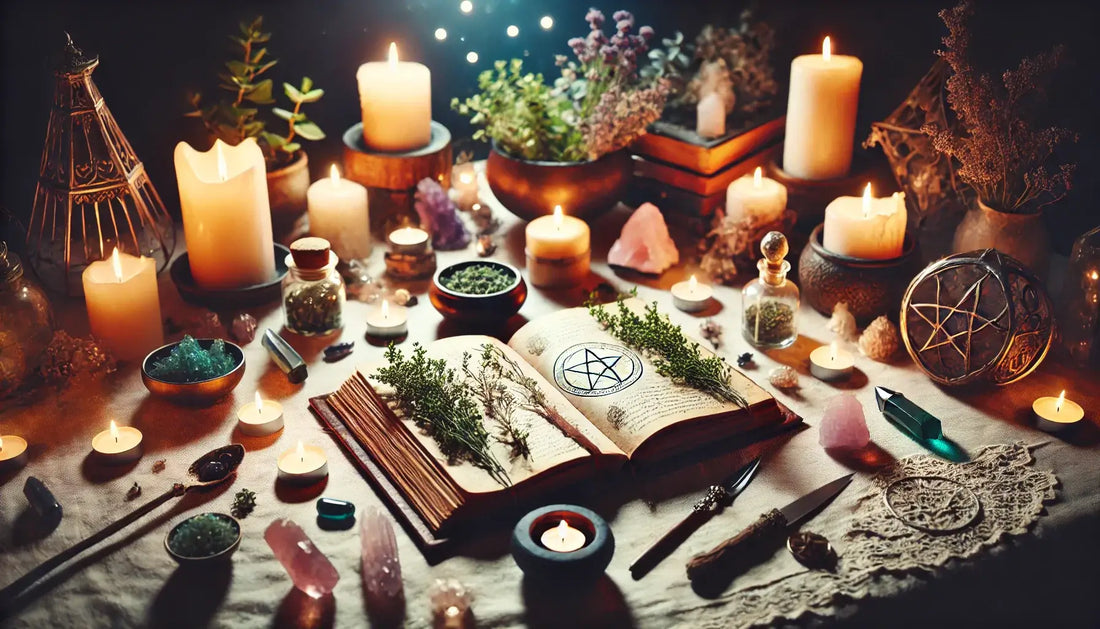
Grimoire Creation 101: Crafting Your Personal Book of Magic
Share
Grimoires, often referred to as books of magic, have been cherished by magicians, witches, and occultists for centuries. They are the keepers of spells, rituals, correspondences, and spiritual insights. Creating your own grimoire can be an empowering way to document your spiritual journey, personalize your magic, and reflect your unique magical practice. Whether you are a beginner or an experienced practitioner, building a grimoire is a rewarding process, rich with creativity and personal significance. Here’s how you can begin your journey into grimoire creation.
Choosing Your Grimoire Format
The first step in creating your own grimoire is to decide on the format. Traditionally, grimoires have been handwritten in journals or notebooks, which adds a personal touch to each page. However, with modern technology, you have the option to create a digital grimoire or even combine both formats.
Handwritten Grimoire: Many practitioners enjoy the tactile experience of handwriting their spells and rituals. A physical grimoire can feel more personal and sacred. You can choose a blank journal or a beautifully designed notebook, depending on what resonates with you.
Digital Grimoire: If you prefer organization and ease of access, a digital grimoire is a great choice. You can store it on your computer or cloud service, making it easier to update, organize, and search for specific information.
Combination: Some people use both formats—writing their spells by hand in a physical journal and keeping additional notes, images, and correspondences in a digital format. This allows for flexibility and creativity.
Selecting a Theme for Your Grimoire
Your grimoire can be as focused or as expansive as you like. Before starting, consider what type of magical practices you’ll be documenting. Your grimoire can follow a general path or dive deeply into specific areas such as:
- Herbalism: Document the magical uses of herbs, potions, and elixirs.
- Divination: Record tarot readings, scrying techniques, and rune interpretations.
- Elemental Magic: Focus on spells, rituals, and correspondences associated with earth, air, fire, and water.
- Astrology: Include insights about the planets, zodiac signs, and how they influence magic.
Alternatively, you can draw inspiration from a specific spiritual tradition or culture, such as Celtic magic, Egyptian mysticism, or Wiccan practices. The theme you choose will guide the type of content you include.
Gathering Materials
Once you've chosen a format and theme, it’s time to gather your materials. Depending on whether you’re working with a physical or digital grimoire, your list of supplies may vary. For a physical grimoire, you’ll need:
- A notebook or journal (preferably one that inspires you)
- Pens, pencils, markers for writing and illustrating
- Tarot cards, herbs, crystals if you plan to attach or document physical items
- Glue or washi tape for attaching items like pressed herbs or photographs
- Scrapbook items like stickers, symbols, or meaningful artwork
For a digital grimoire, gather your tools for organization:
- Word processors (like Google Docs or Microsoft Word) to create and organize entries
- Digital folders to categorize spells, rituals, and references
- Images of tarot spreads, astrology charts, or mystical symbols that complement your writing
Recording Your Magical Knowledge
The heart of your grimoire lies in the knowledge you choose to document. This can range from spells and rituals to more esoteric practices like energy work, sacred geometry, or moon phase correspondences. Consider including:
- Spells: Write down your spell work, including the materials used, incantations spoken, and results observed.
- Rituals: Document rituals for special occasions, Sabbats, moon phases, or personal transformation.
- Correspondences: Create lists of magical correspondences, such as colors, herbs, crystals, planets, and days of the week.
- Tarot & Divination: Record your tarot readings or any insights gained from scrying, runes, or pendulums.
Remember, your grimoire is your personal book of magic, so write down whatever feels most relevant to you. You might also want to include notes on spiritual teachings, deities, or elements of the natural world that resonate with your practice.
Personalizing Your Grimoire
One of the best parts of creating a grimoire is making it uniquely your own. Don’t hesitate to include personal touches that make your book feel sacred and special. Some ideas for personalizing your grimoire include:
- Illustrations: Draw symbols, sigils, or images of deities, plants, and animals.
- Poetry or Quotes: Include your favorite spiritual poetry or quotes that inspire your practice.
- Photographs: Attach photos of sacred places, altars, or nature scenes that carry special meaning.
- Personal Symbols: Create and record your own magical symbols, sigils, or crests to represent your intentions and spells.
Adding these touches can transform your grimoire from a simple journal to a personal treasure trove of magical knowledge and spiritual insights.
Keeping Your Grimoire Safe
Because your grimoire is a deeply personal and powerful tool, it’s important to keep it in a safe place. You may want to store your grimoire in a location where it won’t be disturbed or seen by others—this could be your altar space, a private drawer, or a special box.
For digital grimoires, back up your files regularly to ensure they’re never lost. Some practitioners also password-protect their digital grimoire for added privacy.
Embrace the Magic of Your Grimoire
Creating a grimoire is a deeply personal and magical experience that allows you to document your spiritual journey, reflect on your growth, and connect with your unique practice. Whether you choose to craft a handwritten grimoire or a digital one, remember that there are no rules—it’s all about what feels meaningful and useful to you. Have fun with the process, and let your creativity and intuition guide you. Your grimoire will evolve over time, just as your magical practice does, so enjoy the journey of creating a book of magic that is as unique as you are.
